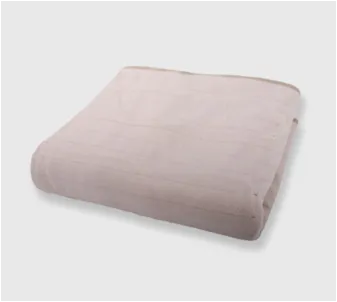
12-р сар . 13, 2024 20:34 Back to list
electric blanket watts per hour
Understanding Electric Blankets Watts Per Hour and Their Efficiency
Electric blankets have become a staple in many households, providing warmth and comfort during cold nights. However, consumers often overlook the importance of understanding the energy consumption of these devices, particularly the watts per hour they use. This article aims to shed light on the power consumption of electric blankets, helping potential buyers make informed choices while considering their electricity bills and environmental impact.
How Electric Blankets Work
Electric blankets are made with insulated wires that heat up when electricity flows through them. The electric current runs through these wires, generating heat that is distributed evenly across the blanket. Most electric blankets come with adjustable heat settings, allowing users to customize their temperature for optimal comfort.
Watts and Energy Consumption
Watts measure electrical power, and in the context of electric blankets, the wattage determines how much energy the blanket uses during operation. For instance, a typical electric blanket may consume between 60 to 100 watts. This figure represents the amount of electricity required to run the blanket for one hour.
To further illustrate this, if you have a 100-watt electric blanket and you use it for five hours, the energy consumption can be calculated as follows
- Energy Consumption (in watt-hours) = Power (in watts) x Time (in hours) - Energy Consumption = 100 watts x 5 hours = 500 watt-hours (Wh) or 0.5 kilowatt-hours (kWh)
Electricity costs vary by region, but the average cost in the U.S. is approximately $0.13 per kWh. So, if you used your blanket for five hours at 100 watts, you would spend roughly $0.065, a small price for a warm, comfortable night.
Factors Affecting Electric Blanket Efficiency
electric blanket watts per hour

Several factors influence how efficiently an electric blanket operates
1. Heat Settings Most electric blankets come with multiple heat settings. Using a lower setting will reduce energy usage. For example, using a low setting for five hours may only consume about 40 watts per hour, significantly lowering your overall cost.
2. Material and Design The type and quality of materials can affect how well the blanket retains heat. Blankets with higher quality insulation will keep you warm with less energy, leading to lower power consumption.
3. Usage Habits How you use the blanket can also substantially impact energy consumption. If you use it just before sleep and turn it off once you're warm, you'll save energy compared to leaving it on all night.
4. Size Larger blankets have more surface area that requires heating and therefore may use more electricity. It's essential to consider the size of the blanket in relation to how many people will be using it.
Environmental Considerations
With rising awareness about climate change and energy conservation, consumers are increasingly interested in the environmental impact of their energy consumption. While electric blankets are generally efficient and safe for everyday use, they still draw electricity, contributing to your overall energy usage. Using an electric blanket wisely—such as during colder months and at lower settings—can minimize your carbon footprint.
Moreover, investing in energy-efficient models can further reduce environmental impact. Look for electric blankets with certifications for energy efficiency, which typically consume less power while providing the same level of warmth.
Conclusion
Understanding the energy consumption of electric blankets in terms of watts per hour can empower consumers to make smarter decisions. By selecting blankets with lower wattage, using them wisely, and considering their environmental impact, you can enjoy the cozy comfort of electric blankets without significant costs and energy waste. Whether it's for a chilly winter night or therapeutic purposes, electric blankets can be a beneficial addition to your home, provided they are used with awareness and responsibility.
-
The Rise of Heated Blankets for Dogs Outdoor
Jun.09,2025
-
Revolutionize Your Sleep with a Heated Mattress Blanket
Jun.09,2025
-
Revolutionize Your Comfort: Discover the Cordless Heated Blanket Advantage
Jun.09,2025
-
Keep Your Pets Warm and Comfortable
Jun.09,2025
-
Experience Warmth Reimagined: Discover the Power of an Electric Blanket
Jun.09,2025
-
Choosing the Best Cat Heating Pad Indoor and Out
Jun.09,2025
Realted Products



